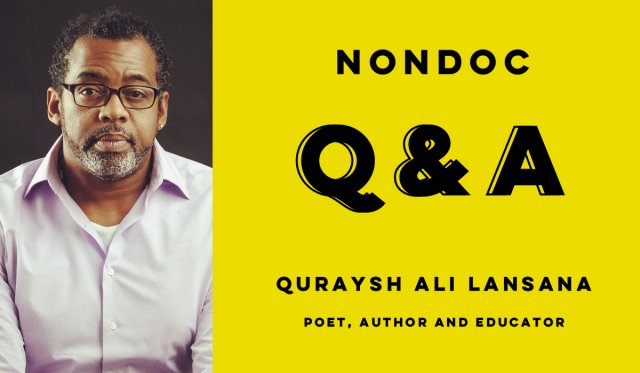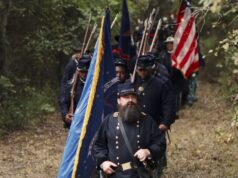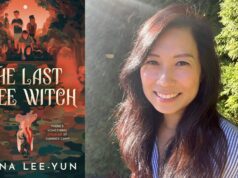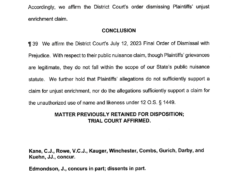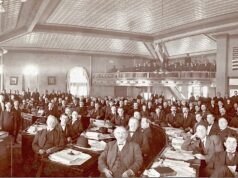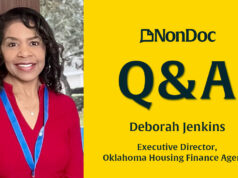
Quraysh Ali Lansana is a poet, author, teacher and editor who has written multiple poetry collections and children’s books and is the editor of a number of anthologies, including Glencoe/McGraw-Hill’s 2001 African American Literature Reader.
Lansana, 56, was born in Enid but spent much of his life outside Oklahoma before returning to live in Tulsa, where he has been a fellow with the Tulsa Artist Fellowship. Before that, however, he was mentored by the poet Gwendolyn Brooks, the first Black author to win a Pulitzer Prize. He has also spent many years teaching writing and developing curriculum and has led workshops in prisons, public schools and universities in more than 30 states.
Since returning to his home state, Lansana has been active in promoting Black history and culture. He helped found the Tri-City Collective, an organization to promote creativity and social justice. He is also the executive producer of Focus: Black Oklahoma, a recently launched NPR show that covers the state’s African American community.
A recent project he has been organizing, Recovering History: Poetry on the Carceral State and Internment, features an event scheduled to take place at the Philbrook Museum on April 30.
Lansana recently spoke to NonDoc about his career and recent work, his approach to creativity and his view of the importance of Black art.
The following phone conversation has been lightly edited for length and clarity.
You were out of Oklahoma for a while. What brought you back?
I was out of Oklahoma for 31 years. Twenty-nine of those in Chicago, and two in New York City. Several things (brought me back). I have been researching the massacre in Greenwood for about 17, 18 years with the plan of writing several books. I’m engaging as a project for the centennial. So that’s one. That has always been the plan — the center of my intellectual focus for quite some time. Two, a personal life change. Three, I was ready to get out of Chicago. My last winter in Chicago lasted literally eight months. It’s too cold, and it’s too damn long, man. That was it for me. And I already had my research (which) was already focused here anyway, so it just made sense. And the timing worked out.
You and Najah-Amatullah Hylton published the children’s book Opal’s Greenwood Oasis this year. What is Opal’s story, and what drove you to write this book?
A part of what it involved for me, outside of the research, is what a dynamic, vibrant, safe, economically successful community Greenwood was before it was destroyed. And I wanted to celebrate. You know, my phrase is I wanted to celebrate Black excellence over Black pain. The massacre is significant. I mean, it’s the worst incident of racial violence in the history of this country. But what was there before the massacre was also one of the, for a time, wealthiest Black communities in the country. I feel like sometimes what Greenwood was before 1921 gets lost and gets overshadowed by the massacre. As an educator, it was important to me — Opal is my fourth children’s book — and so as somebody [for whom] the young people are very, very much important, I wanted to write a book for younger audiences, for younger readers. Because again, this knowledge of Greenwood or the massacre was systematically denied and removed from Oklahoma education and Oklahoma history. And not until the last couple of years has it been legitimately taught in schools. I wanted to make sure that, with all of these projects, but particularly with Opal, they were filling a void and introducing to younger people what Greenwood was: the vibrance, the economic vitality, the culture, the safety.
Thinking about what north Tulsa is today, it’s many of those things and not a lot of those things all at the same time. And there are young people in north Tulsa right now who don’t know what Greenwood was, and what they know is what they see — what they look out the window and see. You can say the same things about northeast OKC. Deep Deuce has been completely gentrified. There are no signs of Black life in Deep Deuce at all. But northeast Oklahoma City was also very vibrant and such, then the series of politics, policies, laws and segregation undermined its vitality. So I wanted to make sure the readers saw an experience of Greenwood and what it was at its height.
But seeing its original vibrance and experiencing that as seen through the eyes of an 8-year-old girl, because there are more children’s books with animals as lead characters than there are children’s books with children of color, with BIPOC children and let alone girl children. So we wanted to make sure that the book had a girl-forward focus and that we are riding through describing the district on Opal’s first bike ride, which is this universal thing that kids can kind of relate to. That first bike ride without your mom and dad or older brother or sister. We wanted to take Opal and travel with her from her safe working-class home, where she had everything she needed, to the grocery store to get cinnamon, which her mom needed to make pies, and provide the opportunity to see the district. All the business and the people and such and celebrate what was there before it was no longer.
What do you think is the most important aspect of all forms of Black art, whether it’s music, dance or other visual forms like film?
Well, I was groomed by Ms. Gwendolyn Brooks, and I was groomed by Black Panthers in Chicago. I was groomed and grounded in the Black arts movement mantra or aesthetic of art by, for and about Black people. And that doesn’t mean others can’t connect with it, but that’s what I’m on: by, for and about Black people. I think, to me, I go back often to a quote from A Tribe Called Quest, of all people. It’s one of Ali Shaheed Muhammad’s samples on Midnight Marauders. And the quote is simply, “Why waste time on the mic?” Right? Why waste time on the mic? I don’t believe that BIPOC people — let me put it like this — BIPOC people can believe in art for art’s sake, but I’m not one of them. I believe in art for expansion, liberation, education and aesthetic beauty. But I believe that art needs to do all of those things. Whether that stands for theater or cinema, I believe that art should enlighten us. It should move us to think but not necessarily tell us what to think. But it should open our minds.
Who are some other poets or authors that you have looked up to or found inspiration in?
I had the great honor and privilege of being mentored by Ms. Gwendolyn Brooks. She was the first Black person to win a Pulitzer. I had the great privilege of being mentored by her for the last decade of her life. She was a cultural grandmother as well as a mentor to my own writing. She was family. I, like many other folks, was introduced to her probably most well-known poem, which is We Real Cool, while I was in eighth-grade reading class while slowly falling in love with this new form of poetry at that time called rap. Those things have converged and helped shape my life. But I’m Ms. Brooks’ last protégé. I’m her last student. She changed my life.
Another mentor would be Dr. Haki Madhubuti. He was the founder and publisher of Third World Press, which is not the first Black-owned publishing company, because that would be Broadside Press and then Johnson Publishing Company — maybe the oldest Black literary press in the country outside of Chicago. (Madhubuti) was one of the most important architects of the Black arts movement. One of the most important voices in the Black arts movement. And he was a mentor for 14 years. A very close mentor for 14 years.
One question I find interesting to ask artists is, who do you write for? Is it yourself? Who’s the audience you write for? Is it a specific person?
I’d be lying to you, and any artist who answers this any differently is not — I think — is not legit. I write for myself. I write because, as Langston Hughes put it, “When you rise it’s important to have something to say.” And so we all write or create in vacuums, but we don’t want our art to stay in a vacuum. We want people to experience it. But I write for myself. If I have an idea like Opal’s Greenwood Oasis, you know, here’s the idea of, I’m going to write this girl-forward book about growing up during the Greenwood massacre, then that’s my idea. I want to write that book understanding there are children out there who I think will benefit from this book, but I’m writing it for myself. I’m writing it because I had this idea, I like the idea, and I think it’s a good idea, and I want to put it out there and see what happens. And I do think if anyone has told you otherwise, they are lying to you.
If you could go anywhere in the world, where would you go and what would you do there?
Well, I would certainly go back to the continent of Africa. For which nation I want to go to, I think right now, at 56 years of age, I really do want to see the pyramids. I really want to go Cario and see the pyramids and the sphinx and experience the grandeur and the majesty and the ingenuity of what remains from that era. I guess second to that I’d love to see Mount Kilimanjaro, and I’d love to go on a safari. I’d love to see giraffes, tigers and lions in their habitats. That would be amazing to me. Those would be my top three. But certainly, right now, Cairo would be my number one.









